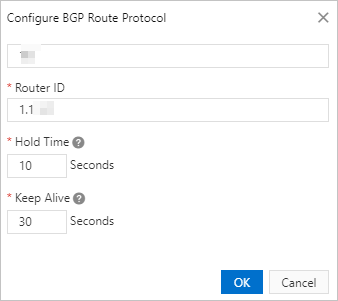Smart Access Gateway (SAG) devices support Border Gateway Protocol (BGP). This topic
describes how to configure BGP routing in the SAG console for an SAG device.
Prerequisites
The type of the SAG device is SAG-1000.
Background information
BGP is a standardized exterior gateway protocol that runs between different autonomous
systems (AS) on the Internet. BGP uses Transmission Control Protocol (TCP) as its
transport protocol. BGP is designed to exchange routing and reachability information
among AS. When an AS needs to exchange routing information with another one, each
of them must have a specified border router. BGP ensures network security, flexibility,
stability, reliability, and efficiency in many ways.
In a large-scale network, BGP is typically used to exchange and control routing information
among multiple AS. SAG devices are typically deployed in one-arm mode if the scale
of the network is large. BGP routes network traffic from a private network to Alibaba
Cloud without changing the existing network topology and requires simple network configurations.
Procedure
- Log on to the Smart Access Gateway console.
- Use one of the following methods to open the Device Management tab.
- Click the ID of the target SAG instance. On the instance details page that appears,
click the Device Management tab.
- Find the target SAG instance and choose in the Actions column.
- On the Device Management tab, click Manage Routes.
- In the BGP Protocol Settings section, click the Edit icon.
- In the Configure BGP Route Protocol dialog box that appears, set the following parameters.

| Parameter |
Description |
| Local AS |
Enter the number of the AS to which the SAG device belongs.
Valid values: 1 to 2147483647.
|
| Router ID |
Enter the BGP router ID of the SAG device.
The ID is an IPv4 address, for example, 192.168.1.1.
|
| Hold Time |
Enter the period of time during which the connection between two peers is maintained.
Valid values: 3 to 65535.
Note The hold time of the peer-to-peer connection between two peer SAG devices must be
set to the same for both devices. If the device does not receive a keep-alive or update
message from the peer device within the hold time, the connection between the BGP
peers is closed.
|
| Keep Alive |
Enter the time interval at which keep-alive messages are transmitted.
Valid values: 0 to 65535.
|
- In the Dynamic Routing Settings section, select Enable BGP Protocol.
- Find the target port and click Edit in the Actions column.
- In the Modify BGP Dynamic Routing Settings dialog box that appears, select whether to enable BGP and click OK.
- Enable BGP: enables BGP. BGP runs between the port and its peer. You must specify the peer IP
address and AS number.
- Disabled: disables BGP for the port.

